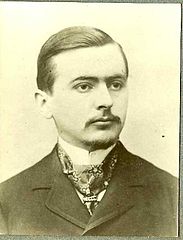This article was published in Scientific American’s former blog network and reflects the views of the author, not necessarily those of Scientific American
Hold on to your hats, my friends, because I have discovered a secret mathematical holiday to observe the last day of this month. This year February 28 happens to be both the day before Lent starts in the western Christian calendar and the 139th anniversary of the birth of mathematician Pierre Fatou (1878-1929). Due to this auspicious confluence of math history, astronomy, the church calendar, and the English language, this year’s Fat Tuesday is Fatou’s Day! Assuming the Vatican and other church authorities don’t alter the way Easter and related holidays are calculated, this concurrence will only happen once more before 2100: in 2090. (It also happened in 2006, but I wasn’t blogging yet, so how would you have known?) You’re going to want to make it count.

A portrait of mathematician Pierre Fatou. Credit: Collection familial Wikimedia
I believe my first encounter with Fatou was in an analysis (read: beefed-up calculus) class when I learned about Fatou’s lemma. This helpful result in calculus is in a family I think of as commutativity statements. (Commutativity is about whether you can do things in a different order and get the same same answer. In math, as in life, one cannot always interchange operations and expect good results. Ask anyone who has sleepily tried to put on their shoes before changing out of their PJs into their real pants. If life were commutative, it would work!) Fatou’s lemma is about the relationship of the integral of a limit to the limit of an integral. Specifically, it says that if the correct conditions are met, then the integral of the limit inferior of a sequence of functions is less than or equal to the limit inferior of the integrals of the functions in the sequence. (For more rigor, check out Wikipedia or Math3ma.)
On supporting science journalism
If you're enjoying this article, consider supporting our award-winning journalism by subscribing. By purchasing a subscription you are helping to ensure the future of impactful stories about the discoveries and ideas shaping our world today.
Fatou is also famous for his contributions to complex dynamics. Basically, he was trying to figure out what happens if you plug a complex number into a function and then plug the output into the same function, lather, rinse, and repeat. I wrote a little more about that idea in my post from a few years ago about fractal kitties and last month’s post about the Mandelbrot set. Basically, sometimes points will stay relatively close to where they start, and sometimes they’ll spiral out wildly to the far reaches of the complex plane. Is there a way to figure out which points do what? The study of complex dynamics eventually led to the definition of Fatou sets and Julia sets. (Julia sets are named after French mathematician Gaston Julia, who studied complex dynamics around the same time as Fatou, though they worked independently.) The Julia set of a polynomial consists of the points that have chaotic behavior near them. That is, some points near them will tumble out to infinity under iteration, and some will stay close. The Fatou set is the complement of the Julia set: all the points surrounded by neighbors who act like they do. They either all flutter away or all stay close to home.
Julia and Fatou sets are often beautiful fractals, as you can see in the gorgeous online book Pictures of Julia and Mandelbrot Sets. Furthermore, they give the most obvious way to connect Fatou’s Day to Fat Tuesday: fractal pancakes. Nathan Shields, whose Saipancakes are #pancakegoals, gives some inspiration at the top of this post. If you don't have his pancake skills, don't worry. Not all Julia and Fatou sets are as photogenic as the Mandelbrot set. It will probably be easier to replicate a pancake resembling one of the components of the Fatou set for the polynomial f(z)=(z+z2)/2 at home.

The inside of this figure, the Julia set for the function f(z)=(z+z2)/2, would make a tasty Fatou's Day pancake. Credit: Wabeki Wikimedia (GFDL 1.2) (CC BY-SA 3.0)
Michèle Audin’s book Fatou, Julia, Montel: The Great Prize of Mathematical Sciences of 1918, and Beyond explains a lot of the ins and outs of Fatou’s and Julia’s work on complex dynamics, putting it in context and addressing questions of priority. It also contains a biographical chapter on Fatou that mentions that he was a music-lover and, at least according to family lore, had a parrot. If you want to do a Fatou deep-dive for Fatou’s Day, I highly recommend that book.
For those looking to make a pilgrimage, Fatou’s birth and death cities are both in Brittany, France: Lorient and Pornichet, respectively. He studied at the École Normale Supérieure in Paris and worked for the rest of his life at the Paris Observatory. He lived at 172 Boulevard du Montparnasse, just around the corner from the observatory, for several years. There is no plaque for him, but I know from experience that it is possible to visit the address and make people look at you weird while you try to get the best possible selfie in front of what is now a dental practice.

Fatou was here. Credit: Evelyn Lamb
Sadly, there is no Rue Fatou among the nearly 100 Paris streets named for mathematicians, but there is a Rue Fatou in Meaux, a town about 25 miles northeast of Paris. The administration of the city of Meaux has not yet answered my email (undoubtedly in bad French) inquiring about the origin of the street's name, so I do not know whether it was named in honor of the mathematician.
So for a perfect Fatou's Day, integrate a sequence of functions, draw some fractals, and eat mathematical pancakes!